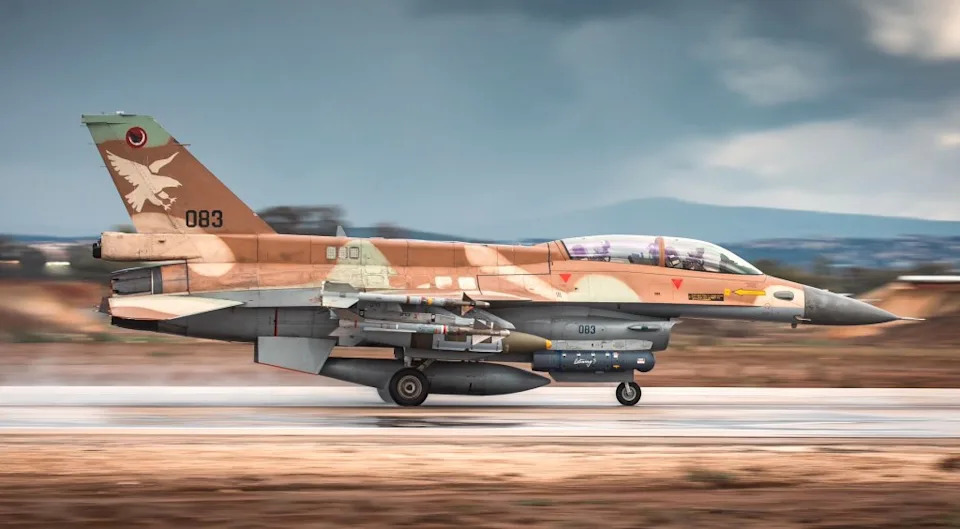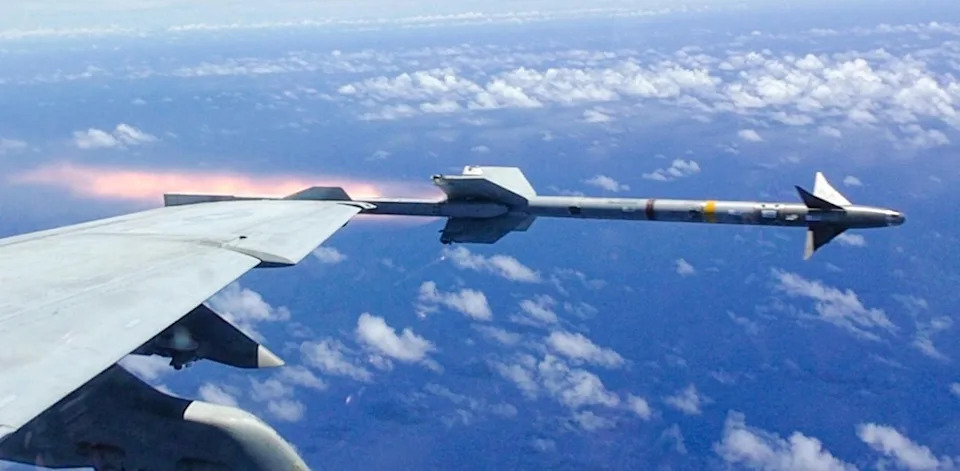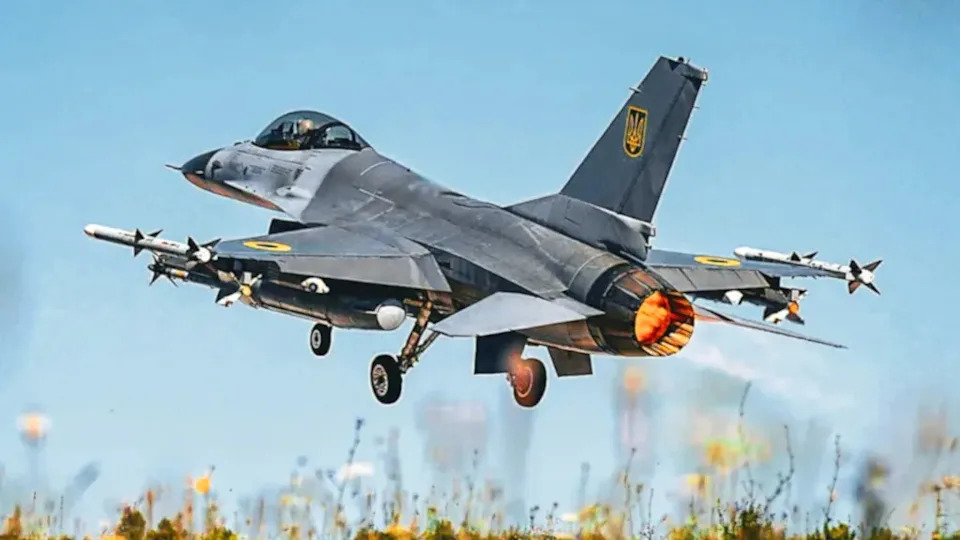Israel’s stocks of AIM-9M Sidewinder air-to-air missiles are now more effective against long-range kamikaze drones like Iran’s Shahed-136, thanks to changes to their seekers, according to a new report. Shahed-type and other similar one-way attack drones present particular challenges for any aerial intercept attempt, given their relatively small size, minimal signiture, slow speed, and low-altitude flight profiles.
The Israeli AIM-9M seeker changes are among the details included in a report on drone defense lessons learned in the wake of Iran’s attacks on Israel on the night of April 13-14, 2024, that the Foreign Policy Research Institute (FPRI) think tank published today. During that barrage, U.S. and other foreign forces joined the Israeli Defense Forces (IDF) to help shoot down dozens of incoming drones and missiles.

An Israeli Air Force F-16 fighter with an AIM-9M Sidewinder missile seen on the outboard station under its left wing. Israeli Air Force
“The defenders quickly surmised that the best weapon to shoot them [incoming long-range one-way attack drones] down is the AIM-9X, the most modern variant of this five-decade-old heat-seeking missile,” FRPI President Aaron Stein wrote, citing an interview with unnamed U.S. Air Force personnel. “The older variant, the AIM-9M, did not work well for the American drone defenders.” It’s also worth noting that the Saudis relied heavily on the AIM-120 AMRAAM to shoot down Houthi drones during its war with the Yemeni group, as the AIM-9 was less reliable. You can read all about that in our previous article here.
The AIM-9X, the baseline version of which first entered U.S. service in 2003, is substantially different, inside and out, from its immediate predecessor, the AIM-9M, as you can read about in more detail here. Among the many changes found on the X variant is a new and advanced imaging infrared (IIR) seeker that can see far further and with much greater fidelity than the one on the M model. The AIM-9X, of which numerous subvariants have since been developed, also features new thrust vectoring and high-off-boresight targeting capabilities to increase its effectiveness against a wide array of threats.

A breakdown of the key components of a current-generation Block II AIM-9X Sidewinder. USN
“The Israeli Air Force, however, has made a change to the AIM-9M’s seeker and employed them with considerable success,” according to FPRI’s report.
The report does not elaborate on the changes and notes that the Israelis “have not yet shared the technology with allies, even the United States.”

An AIM-9M Sidewinder is visible on the right wingtip of this Israeli Air Force F-16I fighter. The jet is also carrying an Israeli Python 3 air-to-air missile and a Joint Direct Attack Munition (JDAM) precision-guided bomb under its right wing. Israeli Air Force
It isn’t clear what was modified, and if it was hardware or software based, or both, to increase its effectiveness against smaller, slower-flying targets, especially at lower altitudes, where various kinds of ‘clutter’ on the surface below can hamper detection and tracking. “Seeker” here could also be shorthand for a broader set of modifications to the Israeli AIM-9Ms. As something of a tangential example, years ago, the U.S. Army added new proximity fuzes featuring small conformal radar antennas to existing FIM-92 Stinger short-range, heat-seeking surface-to-air missiles to improve their effectiveness against various targets, and particularly drones.

An AIM-9M Sidewinder seen at the moment of launch. USN
FPRI highlights these underlying issues in talking about the difficulties that U.S. and other foreign fast jet pilots experienced just in trying to find Iranian drones, let alone shoot them, on the night of April 13-14, 2024. TWZ has been underscoring these challenges on for years now, as well.
“The issue with the slow, low-flying drones is that they travel at about the same speed as a fast-driving vehicle. The speed the Shahed flies is far slower than most other flying objects,” according to FPRI’s report, again citing an interview with unnamed U.S. Air Force personnel. “They are also flying very low to the ground and ‘if drones are near roads it is going to complicate radar and sanitization.’ The defender then has to use an ‘[electro-optical] or [infrared] sensor to tell if it is a car or a drone.’”
As an aside here, several U.S. Air Force F-15E Strike Eagle crews unsuccessfully tried to take down Iranian long-range kamikaze drones on the night of April 13-14, 2024, with Laser Joint Direct Attack Munition (LJDAM) precision-guided bombs after running out of missiles, something TWZ was first to report. The very vaguely ‘car-like’ attributes of those one-way attackers were brought up as part of the reason why this was even attempted. LJDAMs are designed to engage targets on the surface, including ones on the move.
“The Royal Air Force, which flew defensive missions that night, has the option to ‘set their speed filter on their mechanically scanned radars to zero.’” FPRI’s report continues. “The problem, of course, is that it will then ‘pick up everything that is moving against the flat desert background.’ This required the Royal Air Force to work closely with the US Air Force to ‘point them out’ and then transmit data “via link 16 [datalinks]’ for them ‘to get their kills.’”
“The US Air Force, in contrast, were all operating more modern radars and carrying the Sniper [targeting] pod. This allowed for the pilots to use the radar to find the targets and then to identify them with the Sniper pod’s infrared sensor,” the report adds. “The Shaheds have no lights, so they are hard to spot visually. They do, however, put off a very small infrared signature, which allows for their visual identification with the pod. Their most obvious characteristic, as it turns out, is the noise that the engine puts, which is audible to the naked ear within a couple miles on the ground.”
In regard to the last point above, it is interesting to note that Ukrainian forces have fielded a network of acoustic sensors to help spot incoming Russian standoff weapon attacks, which are largely carried out using variants and derivatives of the Shahed-136. The U.S. military has also now been experimenting with similar capabilities based on observations from Ukraine.
To go back to the Israeli modified AIM-9Ms, FPRI is now advocating for that country to share how it has changed those missiles with allies and partners like the United States. Though it is increasingly being supplanted by the AIM-9X, the AIM-9M remains in active U.S. service. Other countries continue to employ M variant Sidewinders, as well.
Improved counter-drone capabilities for the AIM-9M could be particularly valuable for Ukraine, which now employs these missiles regularly from its fleet of Western-supplied F-16s. Those jets are routinely used to hunt incoming drones. There have been indications in the past that Ukraine has fielded AIM-9Ms in the surface-to-air mode, as well. Authorities in the country have notably shown uncrewed surface vessels (USV) armed with M variant Sidewinders, but it is unclear if that combination has been used operationally. In June, Ukrainian Lt. Gen. Kyrylo Budanov, head of Ukraine’s Defense Intelligence Directorate (GUR), told TWZ that USVs had been firing AIM-9Xs during actual missions.

A Ukrainian F-16 carrying AIM-9Ms, as well as AIM-120 Advanced Medium Range Air-to-Air Missiles (AMRAAM). Ukrainian Air Force

A Ukrainian Magura V7 uncrewed surface vessel armed with a pair of AIM-9M Sidewinder missiles. Ukraine Defense Intelligence Directorate
FPRI’s report does note that the U.S. Air Force has already pursued a very effective alternative air-to-air munition for use against drones. This is the Fixed Wing, Air Launched, Counter-Unmanned Aircraft Systems Ordnance (FALCO) version of the laser-guided 70mm Advanced Precision Kill Weapon System II (APKWS II) rocket. Originally developed as an air-to-surface weapon, all APKWS II rockets consist of a standard motor, one of several warhead options, and a laser guidance section in between. The FALCO configuration includes a proximity fuze and other changes to improve its effectiveness in the air-to-air role. It is worth noting here that APKWS II rockets are also now combat-proven in the surface-to-air and surface-to-surface roles.
Air Force F-16s first began using the FALCO rockets operationally to shoot down enemy drones sometime last year, as TWZ was first to report. The service’s F-15E Strike Eagles and A-10 Warthog ground attack jets can also now employ the air-to-air-optimized laser-guided rockets. This is a capability that is likely to continue expanding beyond those platforms.
Though they offer immense magazine depth and cost benefits, FALCO rockets are not without limitations, as TWZ has highlighted in the past. This includes the need to ‘laze’ or designate the target through the entire intercept attempt. The rockets are not able to aggressively maneuver and can only effectively be employed against relatively steady flying, non-reactionary, low-performance targets like drones, as well as subsonic cruise missiles. Work is underway on a new dual-mode guidance system for the APKWS II that adds an imaging infrared seeker to improve its effectiveness against aerial targets, as well as ones on the surface, but it still won’t be on the same level, capability-wise, as a traditional air-to-air missile like the AIM-9X.
Even with the introduction of the specialized air-to-air version of the APKWS II, Air Force jets have continued to fly patrols in the Middle East (and elsewhere) with air-to-air loadouts that include AIM-9M and AIM-9X Sidewinders, as well as AIM-120 Advanced Medium Range Air-to-Air Missiles (AMRAAM).

A pair of US Air Force F-16s seen flying somewhere over the Middle East earlier this year with mixed air-to-air loadouts that include 70mm rocket pods, AIM-9M and AIM-9X sidewinders, and AIM-120 AMRAAMs. USAF
If nothing else, Israel’s reported changes to the seekers on its AIM-9M missiles are another example of how existing munitions are being adapted in response to the growing threats posed by drones.
Contact the author: joe@twz.com

